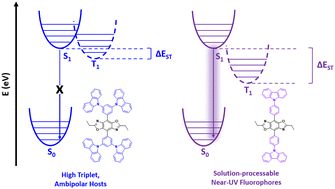Carbazole-substituted benzobisoxazoles: near-UV fluorescent emitters and ambipolar hosts for organic light-emitting diodes†
Abstract
The design of organic light emitting diode (OLED) materials with the potential for exhibiting thermally-activated delayed fluorescence (TADF) is reported. Using computational methods (DFT/TD-DFT) as a guiding tool, six materials with a benzobisoxazole (BBO) core and donor–acceptor–donor architectures were designed by changing the conjugation position of carbazole-substituted phenyl substituents and the type of BBO isomer (cis- vs. trans-). Experimental steady-state and transient absorption spectroscopic techniques were utilized to probe the TADF activity of these molecules. Each material was then used in host–guest OLED devices as either near-UV dopants or host with low singlet-triplet energy differences. The electroluminescent properties show that when used as dopants these materials provide near-UV emission (CIEy < 0.06 and CIEx = 0.16), whereas when used as hosts, these materials show reduced operating voltages and increased performance efficiencies when compared to commercial materials.

- This article is part of the themed collections: 10th Anniversary: Most popular articles and Celebrating International Women’s Day: Women in Materials Science


 Please wait while we load your content...
Please wait while we load your content...